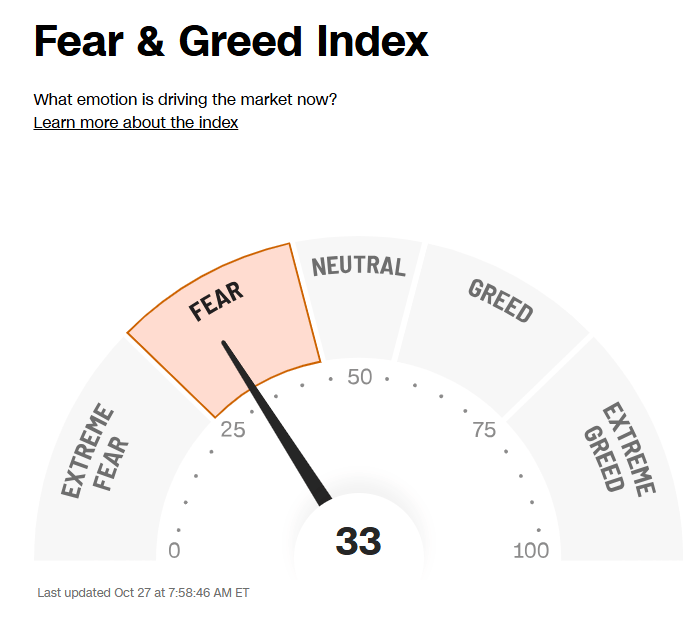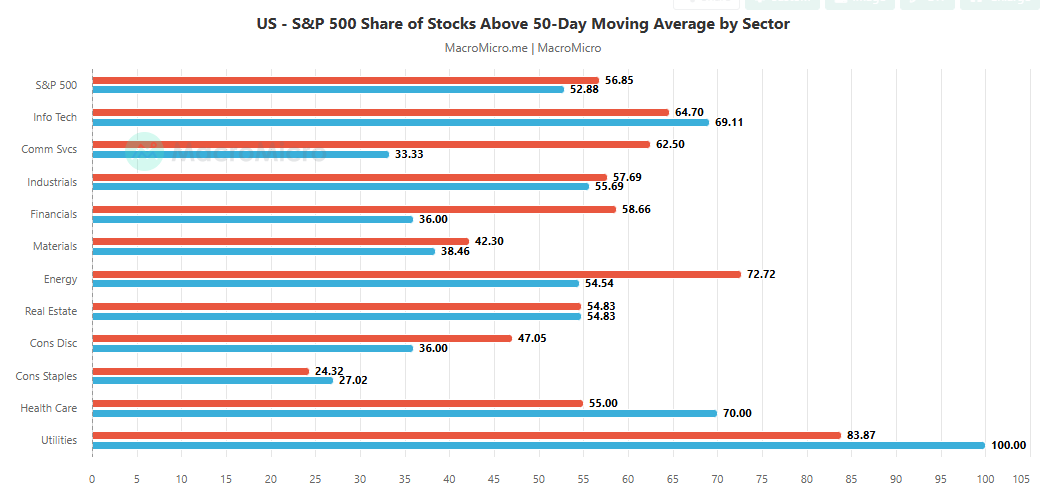- The C.R.E.A.M. Report
- Posts
- Analysts Are Wrong Yet Again About AI...
Analysts Are Wrong Yet Again About AI...
It's All About Compute...


Above Average Info For The Average Joe…
WHEN INVESTING BECOMES A LIFESTYLE YOU WEAR IT!
NEW MERCH ALERT - WEALTHY RED - Limited Quantities - Grab Yours Today! CLICK HERE

WEALTHY RED…



Let The Eat Cake…
WELCOME TO THE HUNGER GAMES….
It’s Day 28 of America’s favorite reality show, “Congress Pretends to Care,” where Republicans gallop in on white horses claiming they’ve come to rescue Lady Liberty from the evil babysitters in blue — while the Democrats, wearing their best Serious Adult Faces™ and clutching copies of The New York Times, wail about “irresponsible governance” like toddlers who misplaced their juice boxes.
On one side of the aisle, you’ve got the GOP, the self-anointed firefighters who first doused the Capitol in kerosene just so they could kick down the doors with buckets of freedom water.
Speaker Mike Johnson is doing his best superhero impression, except in this comic book, his cape is a debt ceiling chart, and his weapon of choice is a PowerPoint titled “Fiscal Responsibility versus Blame-Shifting!”
They claim they’re “fighting to save America’s wallet,” but if you peek behind the curtain, you’ll see them printing commemorative shutdown posters as fundraisers. “We’re trimming government waste!” they say, right after voting to fund a study on the moral character of bald eagles.
Meanwhile, President Trump insists this is a teachable moment — for Democrats, for bureaucrats, for the American people, really anyone within 500 miles of a microphone.
If the economy tanks, that’s just proof the government was too bloated anyway. “When the checks stop flowing, the patriots start glowing,” he reportedly told aides and then proceeded to build a new wing in the white house.
Then there’s the Democratic delegation, dressed like they’re auditioning for C-SPAN: The Musical.
They stand solemnly in front of cameras insisting that cutting Affordable Care Act premiums and restoring Medicaid funding is the “moral imperative of our generation.”
They’d have a stronger case if they weren’t simultaneously launching GoFundMe’s for furloughed staffers while arguing about pronouns in their press releases.
Schumer, Jeffries, and friends have made the Senate floor their stage for “Moral Outrage Theater.” There’s been a 22-hour filibuster speech — a performance art piece involving tears, statistics, and something about Vermont families paying $25,000 for health insurance.
The Democrats demand compassion; the Republicans demand spending cuts; and the American public demands Snap Benefits.
By now, most of Washington resembles a kindergarten recess gone wrong: everyone pointing fingers, no one sharing crayons, and one kid threatening to tell the teacher (but the teacher is furloughed).
At its core, this shutdown — officially is approaching the longest in U.S. history (35 Days) — began over health care subsidies and budget cap fights. Democrats wanted tax credit renewals to avoid higher insurance premiums; Republicans wanted to cut “wasteful programs” (by which they mean anything that doesn’t involve the Pentagon or flag-making).
Somewhere between the dueling bills, the word “compromise” disappeared from the congressional dictionary.
Back home, 900,000 federal employees are on unpaid vacation, 2 million others are working for free, and the economy’s losing billions each week. But in Capitol land, every speech ends with applause — from whichever cameras are still running.
And to add spice, the administration has started giving federal employees politically motivated out-of-office auto-replies. That’s right — click send, and your inbox blames “Democrats for hating America.” HR called it illegal; social media called it “content.”
In D.C., Starbucks lines now double as informal therapy groups for bureaucrats. Smithsonian docents have joined local improv troupes (“Tonight’s theme: Survival on $0”). The Pentagon, of course, keeps humming along — someone’s got to keep the lights on while the Capitol plays Hunger Games.
Republicans claim victory is near. Democrats claim moral vindication. The rest of us claim “insufficient funds.”
And yet, somewhere in a Capitol hallway, a bipartisan staffer whispers, “Maybe we should just… pass something?” only to be tackled by both sides for inappropriate optimism.
So here we are, folks — government closed, tempers open, egos inflated, and the beat goes on. The GOP keeps pretending to slay the budget dragon while actually fighting its reflection. The Democrats stomp their feet wearing “adults in the room” badges, unaware they’re standing in a political sandbox in depends.
At this rate, the only thing reopening soon will be campaign donation portals. But take heart: when the shutdown finally ends — after enough closed-door “meetings” at steakhouses — both sides will emerge before cameras, declare victory, and promise that “the American people won.”
That’s Washington for you: where everyone saves the day after setting the house on fire, and the taxpayers get to toast marshmallows in the ashes.
WHEN INVESTING BECOMES A LIFESTYLE YOU WEAR IT!
NEW MERCH ALERT - BILL GATES BLACK - Limited Quantities - Grab Yours Today! CLICK HERE

BILL GATES BLACK…
ANALYSTS ARE WRONG YET AGAIN ABOUT AI..
Wall Street analysts treating the future like it’s a rerun of Friends. The Street is still underestimating just how much compute—the raw processing firepower—humanity will need to make AI actually work.
Let’s start with the basics: AI models don’t run on dreams and whitepapers—they run on chips, energy, and air-conditioned data centers so massive they could host the Super Bowl indoors. OpenAI’s GPT models reportedly use hundreds of thousands of Nvidia H100-class GPUs, each one slurping about 700 watts of power like it’s a milkshake. For context, generating a million AI tokens—the stuff ChatGPT spits out—isn’t free; it’s measured in megawatt-hours.
By 2027, analysts expect total data center power demand to double to around 1,065 terawatt-hours, according to McKinsey estimates, rivaling the energy consumption of Japan. Nvidia, AMD, and Broadcom aren’t just selling chips—they’re selling the shovels in the new digital gold rush. And yet…
Wall Street thinks it’s 1999 again.
Every decade needs a financial villain. In the 2000s, it was “eyeballs.” In the 2020s, it’s “tokens.” Analysts, still scarred from their NASDAQ dot-com therapy sessions, now see every AI company as a dot.com sequel waiting to implode. They fear being caught again with their pants around their ankles recommending another hype stock when the symphony stops.
But AI is not the dot-com bubble 2.0—it’s the infrastructure phase of something exponentially larger. Back then, we had websites that barely loaded. Now, we have AI models that write websites.
The dot-com era’s problem wasn’t that people saw the internet coming—it’s that they didn’t have the hardware, fiber optics, or compute to deliver what the hype promised. AI’s power problem is the inverse: the hype matches the math. Model size scales almost perfectly with compute. According to Nvidia research, training compute has been doubling every 3.5 months. That’s way faster than Moore’s Law ever dreamed.
So when analysts say “AI is overvalued,” they’re confusing valuation with intellectual laziness.
Wall Street’s favorite bedtime story goes like this: “CapEx spending hurts margins.”
That used to be true when companies built factories that rusted.
But hyperscalers—Microsoft, Google, Amazon—now build compute factories that print money. Microsoft has increased its capital expenditures by over 70% year-over-year, crossing $18 billion per quarter. Yet its Azure and AI-related revenue has grown by even more. Alphabet and Amazon show the same trend: every billion they spend builds capacity for another trillion tokens of generative output.
Let’s say it loudly for the analysts in the back office clutching discounted cash flow spreadsheets like rosaries: In AI, CapEx is not cost. It’s margin expansion in disguise.
These companies don’t buy servers—they buy leverage over the physics of thought itself.
AI cost is now measured in “tokens per kilowatt-hour,” which is an unholy mashup of CPU cycles, electricity, and economics that makes most analysts’ PowerPoints explode. The top AI models will likely consume over 10 million GPU equivalents by the end of the decade. That’s more GPUs than Tesla has cars on the road.
Meanwhile, Wall Street is busy checking Oracle’s dividend yield like it’s 1996 again.
Don’t get me wrong, Oracle and Dell are fine businesses. They’re the plumbing of the AI world. But you don’t get rich buying pipes—you get rich owning what flushes through them. Yet time and again, analysts choose comfort over conviction, safety over insight, beige over brilliance.
It’s financial Stockholm Syndrome: they long for enterprise software spreadsheets while the world moves toward AGI. Their research notes sound like breakup letters to innovation: “We like AI exposure but prefer predictable cash flows.” Translation: “We don’t understand exponential curves and it makes our compliance department nervous.”
Let’s be fair. The dot-com bubble built websites that couldn’t deliver on their page-load promises. AI, in contrast, is delivering tangible productivity. Goldman Sachs expects AI to boost global GDP by 7% or $7 trillion by 2034. IDC forecasts global AI spending will hit $500 billion annually by 2027, nearly doubling in just three years.
And behind that spending? Compute demand that grows faster than chip fabs can be built. That’s why TSMC’s next-generation facilities are booked out through 2028. Nvidia’s supply chain is running so hot that even AMD’s Lisa Su is starting to look like she trained her own demand model.
Dot-com startups needed users. AI networks need electrons. You can fake web traffic; you can’t fake watts.
Analysts love models that fit neatly in Excel. The problem? AI doesn’t scale in Excel—it scales logarithmically. This isn’t about price-to-earnings; it’s about price-to-energy.
The market’s misunderstanding can be summed up like this: they still think the AI race will be won by clever code. It won’t. It’ll be won by whoever builds the largest, most efficient compute grid on Earth. Think of it as a Cold War—but with GPUs instead of nukes.
Wall Street keeps chasing software revenue while missing that the real compounding happens in hardware, CapEx, and control of tokens. The companies that dominate AI infrastructure—Nvidia, Microsoft, Amazon, Alphabet—aren’t speculating. They’re arming up for a multi-decade platform shift that turns compute into the new currency of productivity.
Meanwhile, analysts are writing “sector-neutral exposure notes” about Dell.
AI isn’t a bubble. It’s a power law. And those who misunderstand power laws always think bubbles are popping. What’s really happening is scale—pure, unrelenting scale—driven by data, demand, and digital intelligence.
So the next time you hear someone on CNBC mutter, “AI is a bubble,” ask yourself: Do they understand how many GPUs it takes to make ChatGPT answer that question?
Because if they don’t—they’re looking at the toaster, not the transformer.
Era/Metric | Dot-Com Bubble (1995-2001) | AI Infrastructure Boom (2022–2025) |
|---|---|---|
CapEx Share of US GDP | 1% (telecom/data center peak) | 1.2% (AI data centers in 2025) |
Annual Global CapEx | ~$300 billion peak (internet/telecom) | $1 trillion+ in 2025 (just 8 mega-AI projects) |
Projected Total CapEx | $1.5 trillion total (telecom/internet buildout) | $6.7–7 trillion by 2030 (data centers alone |
Investors Funding | Mostly telecom and internet giants | Hyperscalers + VC-backed AI startups |
Revenue Generated | >$300 billion/year by 1998 | <$20 billion/year “AI native” revenue |
Power Demand (US) | 58 TWh in 2014 (post dot-com) | 176 TWh in 2023, up to 580 TWh by 2028 (AI) |
Growth Rate (Capacity) | Single digits CAGR for data centers | 13–20% CAGR through 2030 for AI IT capacity |
Biggest Players | Cisco, AT&T, Vodafone, Nortel, Lucent | Nvidia, Microsoft, Google, Meta, Amazon, Oracle |
What They Missed | Apps followed after fiber build-out (late profit realization) | Compute demand explosively linked to AI token growth |
WHEN INVESTING BECOMES A LIFESTYLE YOU WEAR IT!
NEW MERCH ALERT - BUY THE DIP NAVY - Limited Quantities - Grab Yours Today! CLICK HERE

BUY THE DIP NAVY…
Quick Links…
The March Of Dimes…
Shut It Down …
Follow The Money…
Thank you for reading, we appreciate your feedback—sharing is caring.
Reply